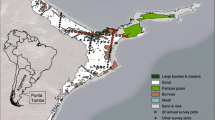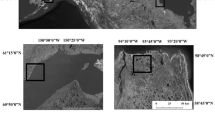Abstract
Habitat for wide-ranging species should be addressed at multiple scales to fully understand factors that limit populations. The marbled murrelet (Brachyramphus marmoratus), a threatened seabird, forages on the ocean and nests inland in large trees. We developed statistical relationships between murrelet use (occupancy and abundance) and habitat variables quantified across many spatial scales (statewide to local) and two time periods in California and southern Oregon, USA. We also addressed (1) if old-growth forest fragmentation was negatively associated with murrelet use, and (2) if some nesting areas are more important than others due to their proximity to high quality marine habitat. Most landscapes used for nesting were restricted to low elevation areas with frequent fog. Birds were most abundant in unfragmented old-growth forests located within a matrix of mature second-growth forest. Murrelets were less likely to occupy old-growth habitat if it was isolated (> 5 km) from other nesting murrelets. We found a time lag in response to fragmentation, where at least a few years were required before birds abandoned fragmented forests. Compared to landscapes with little tono murrelet use, landscapes with many murrelets were closer to the ocean's bays, river mouths, sandy shores, submarine canyons, and marine waters with consistently high primary productivity. Within local landscapes (≤ 800ha), inland factors limited bird abundance, but at the broadest landscape scale studied (3200 ha), proximity to marine habitat was most limiting. Management should focus on protecting or creating large, contiguous old-growth forest stands, especially in low-elevation areas near productive marine habitat.
Similar content being viewed by others
References
Agee J.K. 1993. Fire ecology of Pacific Northwest forests. Island Press, Washington, DC, USA.
Atzet T.R. and Wheeler D.L. 1982. Historical and ecological perspectives on fire activity in the Klamath Geological Province of the Rogue River and Siskiyou National Forests. U.S. Forest Service General Technical Report R6-Range-102-1982., Corvallis, OR, USA.
Burnham K.P. and Anderson D.R. 1998. Model selection and inference: a practical information-theoretic approach. Springer-Verlag, New York, NY, USA.
Burkett E.E. 1995. Marbled murrelet food habits and prey ecology. In: Ralph C.J., Hunt G.L., Raphael M.G. and Piatt J.F. (eds), Ecology and Conservation of the Marbled Murrelet. U.S. Forest Service General Technical Report PSW-GTR-152, Albany, CA, USA, pp. 247-254.
CTTF (California Timberland Task Force) 1993. The report of the California Timberland Task Force. California Department of Forestry and Fire Protection, Strategic Planning Program, Sacramento, CA, USA.
Chen J., Franklin J.F. and Spies T.A. 1993. Contrasting microclimates among clearcut, edge, and interior old-growth Douglas-fir forest. Agricultural and Forest Meteorology 63: 219-237.
Clark R.G. and Shutler D. 1999. Avian habitat selection: pattern from process in nest-site use by ducks? Ecology 80: 272-281.
Cody M.L. 1973. Coexistence, coevolution and convergent evolution in seabird communities. Ecology 54: 31-44.
Congalton R.G., Green K. and Teply J. 1993. Mapping old-growth forests on national forest and park lands in the Pacific Northwest from remotely sensed data. Photogrammetric Engineering & Remote Sensing 59: 529-535.
Cressie N.A.C. 1993. Statistics for Spatial Data. Wiley, New York, NY, USA.
Daly C., Nelson R.P. and Phillips D.L. 1994. A statistical-topographic model for mapping climatological precipitation over mountainous terrain. Journal of Applied Meteorology 33: 140-158.
Daniel T.W. 1942. Comparative Transpiration Rates of Several Western Conifers under Controlled Conditions. Ph.D., University of California, Berkeley, USA.
Dillingham C.P., Miller R.C. and Webb L.O. 1995. Marbled murrelet distribution in the Siskiyou National Forest of southwestern Oregon. Northwestern Naturalist 76: 33-39.
Divoky G.J. and Horton M. 1995. Breeding and natal dispersal, nest habitat loss and implications for marbled murrelet populations. In: Ralph C.J., Hunt G.L., Raphael M.G. and Piatt J.F. (eds), Ecology and Conservation of the Marbled Murrelet. U.S. Forest Service General Technical Report PSW-GTR-152, Albany, CA, USA, pp. 83-87.
Franklin J.G. and Dyrness C.T. 1973. Natural vegetation of Oregon and Washington. U.S. Forest Service General Technical Report PNW-8., Portland, OR, USA.
Freilich J.E., Burnham K.P., Collins C.M. and Garry C.A. 2000. Factors affecting population assessments of desert tortoises. Conservation Biology 14: 1479-1489.
Ganter B. and Cooke F. 1998. Colonial nesters in a deteriorating habitat: site fidelity and colony dynamics of lesser snow geese. Auk 115: 642-652.
Grenier J.J. and Nelson S.K. 1995. Relationship of marbled murrelets with habitat characteristics at inland sites in California. In: Ralph C.J., Hunt G.L., Raphael M.G. and Piatt J.F. (eds), Ecology and Conservation of the Marbled Murrelet. U.S. Forest Service General Technical Report PSW-GTR-152, Albany, CA, USA, pp. 191-204.
Haig S.M., Mehlman D.W. and Oring L.W. 1998. Avian movements and wetland connectivity in landscape conservation. Conservation Biology 12: 749-758.
Hamer T.E. 1995. Inland habitat associations of marbled murrelets in western Washington. In: Ralph C.J., Hunt G.L., Raphael M.G. and Piatt J.F. (eds), Ecology and Conservation of the Marbled Murrelet. U.S. Forest Service General Technical Report PSW-GTR-152, Albany, CA, USA, pp. 163-176.
Hamer T.E. and Nelson S.K. 1995. Characteristics of marbled murrelet nest trees and nesting stands. In: Ralph C.J., Hunt G.L., Raphael M.G. and Piatt J.F. (eds), Ecology and Conservation of the Marbled Murrelet. U.S. Forest Service General Technical Report PSW-GTR-152, Albany, CA, USA, pp. 69-82.
Hansen A.J., Spies T.A., Swanson F.J. and Ohmann J.L. 1991. Conserving biodiversity in managed forests. BioScience 41: 382-392.
Hosmer D.W. and Lemeshow S. 1989. Applied Logistic Regression. Wiley, New York, NY, USA.
Hunt G.L. 1995. Oceanographic processes and marine productivity in waters offshore of marbled murrelet breeding habitat. In: Ralph C.J., Hunt G.L., Raphael M.G. and Piatt J.F. (eds), Ecology and Conservation of the Marbled Murrelet. U.S. Forest Service General Technical Report PSW-GTR-152, Albany, CA, USA, pp. 219-222.
Jodice P.G.R. and Collopy M.W. 2000. Activity patterns of marbled murrelets in Douglas-Fir old-growth forests of the Oregon Coast Range. Condor 102: 275-285.
Labisky R.F., Miller K.E. and Hartless C.S. 1999. Effect of Hurricane Andrew on survival and movements of white-tailed deer in the Everglades. Journal of Wildlife Management 63: 872-879.
Leptich D.J. and Gilbert J.R. 1989. Summer home range and habitat use by moose in northern Maine (USA). Journal of Wildlife Management 53: 880-885.
Manley I.A. and Nelson S.K. 1999. Habitat characteristics associated with nest success and predation at marbled murrelet nest trees. Pacific Seabirds 26: 40.
Marvin G.A. 2001. Age, growth, and long-term site fidelity in the terrestrial plethodontid salamander, Plethodon kentucki. Copeia: 108-117.
Marzluff J.M. and Restani M. 1999. The effects of forest fragmentation on avian nest predation. In: Rochelle J.A., Lehmann L.A. and Wisniewski J. (eds), Forest Fragmentation: Wildlife and Management Implications. Brill Academic Publishing, Leiden, The Netherlands, pp. 155-169.
McGarigal K. and Marks B.J. 1995. FRAGSTATS: spatial pattern analysis program for quantifying landscape structure. U.S. Forest Service General Technical Report PNW-GTR-351., Portland, OR, USA.
Meyer C.B. and Miller S.L. 2002. Marbled murrelet use of fragmented landscapes for nesting in southern Oregon. Conservation Biology (in press).
Meyer C.B. 1999. Marbled murrelet use of landscapes and seascapes during the breeding season in California and southern Oregon. Ph.D., University of Wyoming, Laramie, USA.
Miller G.S., Beissinger S.R., Carter H.R., Csuti B., Hamer T.E. and Perry D.A. 1997. Recovery plan for the threatened marbled murrelet (Brachyramphus marmoratus) in Washington, Oregon, and California. U.S. Fish and Wildlife Service, Portland, OR, USA.
Miller S.L. and Ralph C.J. 1995. Relationships of marbled murrelets with habitat and vegetation characteristics at inland sites in California. In: Ralph C.J., Hunt G.L., Raphael M.G. and Piatt J.F. (eds), Ecology and Conservation of the Marbled Murrelet. U.S. Forest Service General Technical Report PSW-GTR-152, Albany, CA, USA, pp. 205-215.
Mladenoff D.J., White M.A. and Pastor J. 1993. Comparing spatial pattern in unaltered old-growth and disturbed forest landscapes. Ecological Applications 3: 294-306.
Nelson S.K. and Hamer T.H. 1995a. Nesting biology and behavior of the marbled murrelet. In: Ralph C.J., Hunt G.L., Raphael M.G. and Piatt J.F. (eds), Ecology and Conservation of the Marbled Murrelet. U.S. Forest Service General Technical Report PSW-GTR-152, Albany, CA, USA, pp. 57-67.
Nelson S.K. and Hamer T.H. 1995b. Nest success and the effects of predation on marbled murrelets. In: Ralph C.J., Hunt G.L., Raphael M.G. and Piatt J.F. (eds), Ecology and Conservation of the Marbled Murrelet. U.S. Forest Service General Technical Report PSW-GTR-152, Albany, CA, USA, pp. 89-97.
Neter J., Wasserman W. and Kutner M.H. 1989. Applied Linear Regression Models. Richard D. Irwin, Bunridge, IL, USA.
Paton P.W.C. 1994. The effect of edge on avian nest success: how strong is the evidence? Conservation Biology 8: 17-26.
Pearcy W.G. and Schoener A. 1987. Changes in the marine biota coincident with the 1982-83 El Niño in the northeastern subarctic Pacific Ocean. Journal of Geophysical Research 92: 14417-14428.
Pulliam R.H. 1988. Sources, sinks, and population regulation. American Naturalist 132: 652-661.
Ralph C.J. and Miller S.L. 1995. Offshore population estimates of marbled murrelets in California. In: Ralph C.J., Hunt G.L., Raphael M.G. and Piatt J.F. (eds), Ecology and Conservation of the Marbled Murrelet. U.S. Forest Service General Technical Report PSW-GTR-152, Albany, CA, USA, pp. 353-360.
Ralph C.J., Nelson S.K., Shaughnessy M.M. and Miller S.L. 1993. Methods for surveying for marbled murrelets in forests. Oregon Cooperative Wildlife Research Unit, Oregon State University, Corvallis, OR, USA, Technical paper # 1.
Raphael M.G., Young J.A. and Galleher B.M. 1995. A landscapelevel analysis of marbled murrelet habitat in western Washington. In: Ralph C.J., Hunt G.L., Raphael M.G. and Piatt J.F. (eds), Ecology and Conservation of the Marbled Murrelet. U.S. Forest Service General Technical Report PSW-GTR-152, Albany, CA, USA, pp. 177-189.
SAS Institute 1990. SAS/STAT user's guide, release 6.12. SAS Institute Inc., Cary, NC, USA.
Schoenherr J.R. 1991. Blue whales feeding on high concentrations of euphausiids around Monterey Submarine Canyon. Canadian Journal of Zoology 69: 583-594.
Somers R.H. 1962. A new asymmetric measure of association for ordinal variables. American Sociological Review 27: 799-811.
Strong C.S. 1995. Distribution of marbled murrelets along the Oregon coast in 1992. Northwestern Naturalist 76: 99-105.
Varoujean D.H. and Williams W.A. 1995. Abundance and distribution of marbled murrelets in Oregon and Washington based on aerial surveys. In: Ralph C.J., Hunt G.L., Raphael M.G. and Piatt J.F. (eds), Ecology and Conservation of the Marbled Murrelet. U.S. Forest Service General Technical Report PSW-GTR-152, Albany, CA, USA, pp. 337-338.
Van Horne B. 1983. Density as a misleading indicator of habitat quality. Journal of Wildlife Management 47: 893-901.
Wiens J.A., Adicott J.F., Case T.J. and Diamond J. 1986. Overview: the importance of spatial and temporal scale in ecological investigations. In: Diamond J.T. and Case T.J. (eds), Community Ecology. Harper & Row, New York, NY, USA, pp. 145-153.
Zinke P.J. 1977. The redwood forest and associated north coast forests. In: Barbour M.G. and Major J. (eds), Terrestrial Vegetation of California. Wiley and Sons, New York, NY, USA, pp. 679-698.
Author information
Authors and Affiliations
Rights and permissions
About this article
Cite this article
Meyer, C.B., Miller, S.L. & Ralph, C.J. Multi-scale landscape and seascape patterns associated with marbled murrelet nesting areas on the U.S. west coast. Landscape Ecology 17, 95–115 (2002). https://doi.org/10.1023/A:1016574928706
Issue Date:
DOI: https://doi.org/10.1023/A:1016574928706




